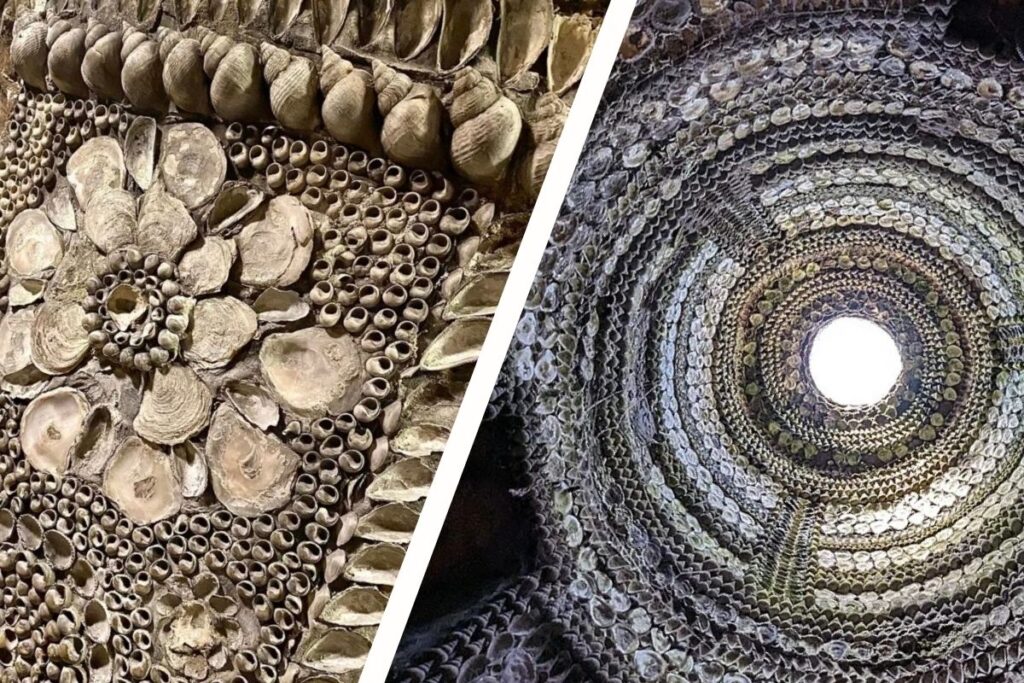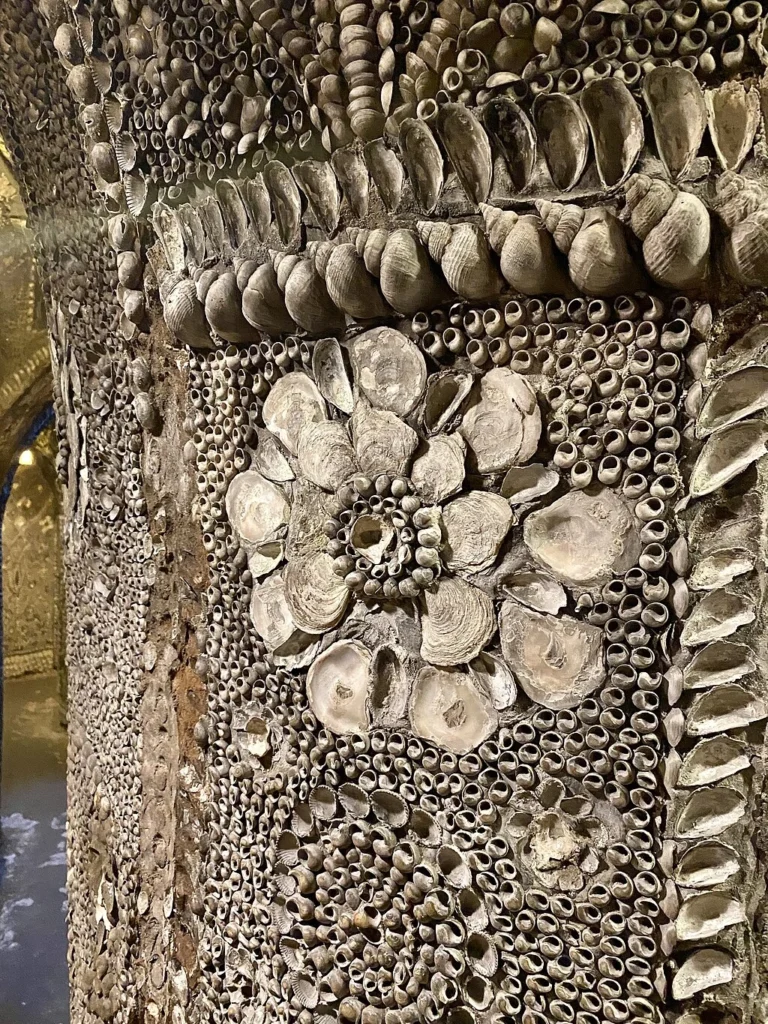
In 1835, a man in the English seaside town of Margate was digging a duck pond in his backyard. His name was James Newlove. While working with his son, he struck something hard beneath the chalky ground. It was not a rock. It echoed when hit.
As they dug further, they uncovered an entrance that led into darkness. What they found below was a narrow passageway, twisting through the earth, its walls completely covered in seashells. They followed it with a candle and stepped into an open chamber, domed at the top. A shaft of daylight came through a hole above them, casting light across the walls. Every surface was covered in shells, with patterns curling across the ceiling and symbols emerging from the stone, though there were no visible signs of tools, names, or dates.



By the following year, the family had opened the place to the public. A short article appeared in a Kent newspaper calling it “curious and interesting.” That description has stayed accurate for nearly two hundred years. The Shell Grotto remains open to visitors, with no verified record of its builder, date of construction, or original purpose.
Every inch covered in shell
The Shell Grotto begins with a staircase that descends into chalk. At the bottom, a narrow tunnel snakes through the ground, barely wide enough for two people. After thirty feet, the walls begin to change. Flat winkles, cockles, mussels, scallops, oysters, and razor clams fill every inch of the surface. Designs appear in the shapes of stars, flowers, vines, and more abstract forms that have been interpreted in many ways.
The tunnel passes into a circular room, then leads to the dome chamber, and ends in a rectangular space often referred to as the Altar Room. The full length is just over 70 feet. The tallest point is just under 8 feet high. Every wall and ceiling is packed with shell mosaics, with an estimated 4.6 million shells in total.

The designs are elaborate and precise. They include a pattern that resembles a tree, a spiraled “tortoise” motif, and another that has been labeled a phallic symbol. These names were added later and have stuck mostly through repetition. Visitors are handed printed guides with the symbols labeled, but there is no way to confirm what they were originally meant to represent.
Most of the shells were likely gathered from local bays, including Walpole Bay, Pegwell Bay, and Sandwich Bay. However, some of the most heavily used shell types, such as the flat winkle, were not abundant in the area and had to be brought in from farther west.
Theories with gaps
There are no reliable written records describing the Grotto’s construction. Over time, this silence created space for theories to grow. Some believe it was built by the Knights Templar. Others claim it was a site for pagan ritual. One pamphlet printed in the 1940s described it as a monument built by a lost tribe of Israelites. A researcher in the 2000s connected it to the Phoenician worship of the god Melqart.
There is a theory that the shell-covered structure was built in Twickenham by the poet Alexander Pope, then moved to Margate and hidden. This was proposed in the early twentieth century and has since been quietly abandoned.

Some explanations are more practical. In the 1700s and 1800s, English landowners often added ornamental shell-lined tunnels or summerhouses to their estates. These were built for decoration or as curiosities. The Margate Grotto shares similarities with these features. The problem is its size, location, and secrecy. Most shell structures were visible and documented. None were as extensive or as thoroughly covered as the Shell Grotto.
The owners of the site have shown interest in solving the question, but research has been slow. A sample taken in the 1960s was carbon-dated to somewhere between 1570 and 1770. That range is too wide to give any clear answer, and only one sample was tested. Conservators later advised that further testing would require destructive methods and significant funding. As of now, there are no confirmed plans for more.
Living with mystery
Since its discovery, the Shell Grotto has remained in private hands. In 1932, its new owner installed electric lighting, replacing gas lamps that had left soot on the walls. A five-year conservation project in the 2010s helped remove moisture and restore damaged areas. The structure was removed from the Heritage at Risk Register in 2012.
A non-profit group called Friends of the Shell Grotto was formed in 2008. They assist with preservation and promote the site as a historic monument. Today, visitors still receive a printed map that highlights patterns and interpretations. Many people come with their own theories, but few leave with firm conclusions.


Theories continue to circulate. Some focus on spiritual symbols. Others argue for 18th-century craftwork. There are even comparisons to a recently discovered Roman cave in Italy that shares similar domed features and decorative shellwork. None offer complete answers.
Tool marks from the modern era are absent. Historical records do not mention of a sponsor or builder. Nobody has ever been officially linked to its construction. The structure stands in full detail, yet the surrounding context remains undocumented and unexplained.
A space that stays open
For many people, the appeal of the Shell Grotto lies in its uncertainty. The absence of clear origin allows for multiple stories to live at once. Some are far-fetched. Others are careful, rooted in design analysis or shell sourcing. None have been confirmed.
It is a quiet place. Its surfaces have faded with age. Much of the original color was lost during the gas lamp years. Cleaning trials revealed that the shells have turned white under soot and dust. Still, the designs remain legible.


For those who visit, the mystery becomes part of the experience. The Grotto presents a space that has avoided being pinned down. In a time when information is easy to find, that kind of ambiguity is unusual. The site remains a place where visitors ask more questions than they answer.
The Shell Grotto was discovered by accident. Its past has never been fully recovered. But it has not been lost either. It remains open, preserved, and quietly strange.

